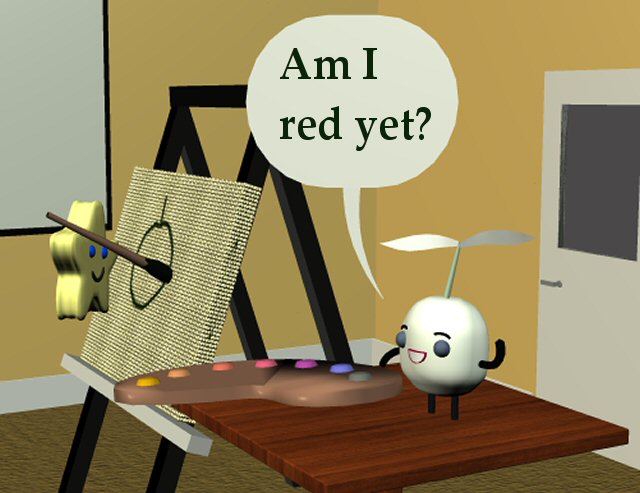Friday, August 07, 2015
More dumb linguists
Dumb linguists think that something called 'dependency length minimization' is the long-sought Linguistic Universal.
 = = = = =
SerenGIFity: See those realistic staples on the side of the canvas stretcher? I didn't put them there. Didn't even think of them. Poser created them accidentally through some kind of aliasing effect.
= = = = =
SerenGIFity: See those realistic staples on the side of the canvas stretcher? I didn't put them there. Didn't even think of them. Poser created them accidentally through some kind of aliasing effect.
The idea is that when sentences bundle related concepts in proximity, it puts less of a strain on working memory. For example, adjectives (like “old”) belong with the nouns that they modify (like “lady”), so it’s easier to understand the whole concept of “old lady” if the words appear close together in a sentence. You can see this effect by deciding which of these two sentences is easier to understand: “John threw out the old trash sitting in the kitchen,” or “John threw the old trash sitting in the kitchen out.” To many English speakers, the second sentence will sound strange—we’re inclined to keep the words “threw” and “out” as close together as we can. This process of limiting distance between related words is called dependency length minimisation, or DLM. Do languages develop grammars that force speakers to neatly package concepts together, making sentences easier to follow? Or, when we look at a variety of languages, do we find that not all of them follow the same pattern?This is purely an artifact of classification. It's true that adjectives cling fairly close to their nouns, but that's not because the adjective is a naturally separate unit. It's simply part of the noun. At least in a fairly sophisticated language, you can always recast an adj+noun combination as a single noun morpheme. It won't always be exact, but it's the same general concept. Old lady = biddy. Old man = coot. Little car = VW. Big car = Cadillac. (Those are factually obsolete now that VW makes huge SUVs and Caddy made the horrible little Seville, but as nouns both are still instantly understandable.) So the adjective is not really a separate word. It's just a separable sememe. As such it normally belongs near its other part, just as separable verb morphemes normally live close to their parents. Here's the debunked crap:
Languages like German and Japanese have markings on nouns that convey the role each noun plays within the sentence, allowing them to have freer word order than English. The researchers suggest that the markings in these languages contribute to memory and understanding, making DLM slightly less important.Inflectional markings certainly have an effect on emotions and culture, though it's a poorly understood concept. I tried to discuss it here. But there's no such thing as free word order. Repeatedly debunked. Free word order is an artistic technique of poets, not a characteristic of actual human language. Assuming that declension enables free word order is like assuming that tomatoes are red because painters can purchase lead-based pigments cheaply.
 = = = = =
SerenGIFity: See those realistic staples on the side of the canvas stretcher? I didn't put them there. Didn't even think of them. Poser created them accidentally through some kind of aliasing effect.
= = = = =
SerenGIFity: See those realistic staples on the side of the canvas stretcher? I didn't put them there. Didn't even think of them. Poser created them accidentally through some kind of aliasing effect.
Labels: Language update, Metrology
